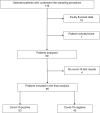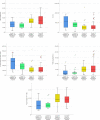Physiological respiratory parameters in pre-hospital patients with suspected COVID-19: A prospective cohort study
- PMID: 34473782
- PMCID: PMC8412304
- DOI: 10.1371/journal.pone.0257018
Physiological respiratory parameters in pre-hospital patients with suspected COVID-19: A prospective cohort study
Abstract
Background: The COVID-19 pandemic has presented emergency medical services (EMS) worldwide with the difficult task of identifying patients with COVID-19 and predicting the severity of their illness. The aim of this study was to investigate whether physiological respiratory parameters in pre-hospital patients with COVID-19 differed from those without COVID-19 and if they could be used to aid EMS personnel in the prediction of illness severity.
Methods: Patients with suspected COVID-19 were included by EMS personnel in Uppsala, Sweden. A portable respiratory monitor based on pneumotachography was used to sample the included patient's physiological respiratory parameters. A questionnaire with information about present symptoms and background data was completed. COVID-19 diagnoses and hospital admissions were gathered from the electronic medical record system. The physiological respiratory parameters of patients with and without COVID-19 were then analyzed using descriptive statistical analysis and logistic regression.
Results: Between May 2020 and January 2021, 95 patients were included, and their physiological respiratory parameters analyzed. Of these patients, 53 had COVID-19. Using adjusted logistic regression, the odds of having COVID-19 increased with respiratory rate (95% CI 1.000-1.118), tidal volume (95% CI 0.996-0.999) and negative inspiratory pressure (95% CI 1.017-1.152). Patients admitted to hospital had higher respiratory rates (p<0.001) and lower tidal volume (p = 0.010) compared to the patients who were not admitted. Using adjusted logistic regression, the odds of hospital admission increased with respiratory rate (95% CI 1.081-1.324), rapid shallow breathing index (95% CI 1.006-1.040) and dead space percentage of tidal volume (95% CI 1.027-1.159).
Conclusion: Patients taking smaller, faster breaths with less pressure had higher odds of having COVID-19 in this study. Smaller, faster breaths and higher dead space percentage also increased the odds of hospital admission. Physiological respiratory parameters could be a useful tool in detecting COVID-19 and predicting hospital admissions, although more research is needed.
Conflict of interest statement
The authors have declared that no competing interests exist.
Figures
Similar articles
-
Changes in presentation, presenting severity and disposition among patients accessing emergency services during the first months of the COVID-19 pandemic in Calgary, Alberta: a descriptive study.CMAJ Open. 2021 Jun 1;9(2):E592-E601. doi: 10.9778/cmajo.20200313. Print 2021 Apr-Jun. CMAJ Open. 2021. PMID: 34074633 Free PMC article.
-
Characteristics and outcomes of patients with COVID-19 admitted to hospital and intensive care in the first phase of the pandemic in Canada: a national cohort study.CMAJ Open. 2021 Mar 8;9(1):E181-E188. doi: 10.9778/cmajo.20200250. Print 2021 Jan-Mar. CMAJ Open. 2021. PMID: 33688026 Free PMC article.
-
Risk factors for severe outcomes for COVID-19 patients hospitalised in Switzerland during the first pandemic wave, February to August 2020: prospective observational cohort study.Swiss Med Wkly. 2021 Jul 28;151:w20547. doi: 10.4414/smw.2021.20547. eCollection 2021 Jul 19. Swiss Med Wkly. 2021. PMID: 34324698
-
The changing spectrum of microbial aetiology of respiratory tract infections in hospitalized patients before and during the COVID-19 pandemic.BMC Infect Dis. 2022 Sep 30;22(1):763. doi: 10.1186/s12879-022-07732-5. BMC Infect Dis. 2022. PMID: 36180842 Free PMC article.
-
Characteristics in Pediatric Patients with Coronavirus Disease 2019 in Korea.J Korean Med Sci. 2021 May 24;36(20):e148. doi: 10.3346/jkms.2021.36.e148. J Korean Med Sci. 2021. PMID: 34032033 Free PMC article.
Cited by
-
Emergency Medical Services Prehospital Response to the COVID-19 Pandemic in the US: A Brief Literature Review.Open Access Emerg Med. 2022 May 30;14:249-272. doi: 10.2147/OAEM.S366006. eCollection 2022. Open Access Emerg Med. 2022. PMID: 35669176 Free PMC article. Review.
-
Cardiac implantable device interrogation in left ventricular systolic dysfunction reveals physiologic abnormalities prior to symptom onset in COVID-19: a case series.Eur Heart J Case Rep. 2022 Oct 3;6(10):ytac404. doi: 10.1093/ehjcr/ytac404. eCollection 2022 Oct. Eur Heart J Case Rep. 2022. PMID: 36285228 Free PMC article.
-
Growth hormone-releasing hormone receptor antagonist MIA-602 attenuates cardiopulmonary injury induced by BSL-2 rVSV-SARS-CoV-2 in hACE2 mice.Proc Natl Acad Sci U S A. 2023 Nov 28;120(48):e2308342120. doi: 10.1073/pnas.2308342120. Epub 2023 Nov 20. Proc Natl Acad Sci U S A. 2023. PMID: 37983492 Free PMC article.
-
Combining reservoir mask oxygenation with high-flow nasal cannula in the treatment of hypoxemic respiratory failure among patients with COVID-19 pneumonia: a retrospective cohort study.Acute Crit Care. 2023 Nov;38(4):435-441. doi: 10.4266/acc.2023.00451. Epub 2023 Nov 23. Acute Crit Care. 2023. PMID: 37994019 Free PMC article.
-
Sports Performance and Breathing Rate: What Is the Connection? A Narrative Review on Breathing Strategies.Sports (Basel). 2023 May 10;11(5):103. doi: 10.3390/sports11050103. Sports (Basel). 2023. PMID: 37234059 Free PMC article. Review.
References
-
- Fernandez AR, Crowe RP, Bourn S, Matt SE, Brown AL, Hawthorn AB, et al.. COVID-19 Preliminary Case Series: Characteristics of EMS Encounters with Linked Hospital Diagnoses. Prehospital Emerg Care Off J Natl Assoc EMS Physicians Natl Assoc State EMS Dir. 2021;25: 16–27. doi: 10.1080/10903127.2020.1792016 - DOI - PubMed
MeSH terms
LinkOut - more resources
Full Text Sources
Medical



